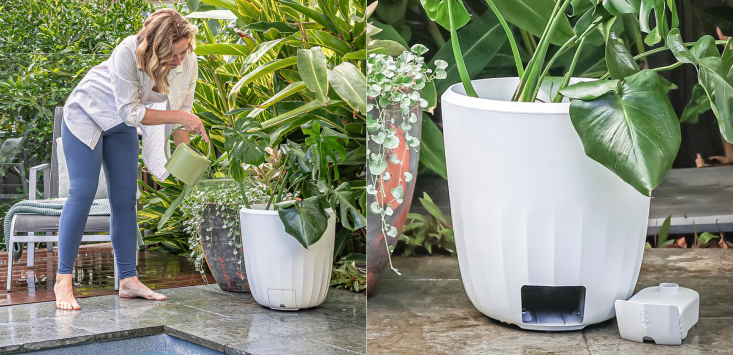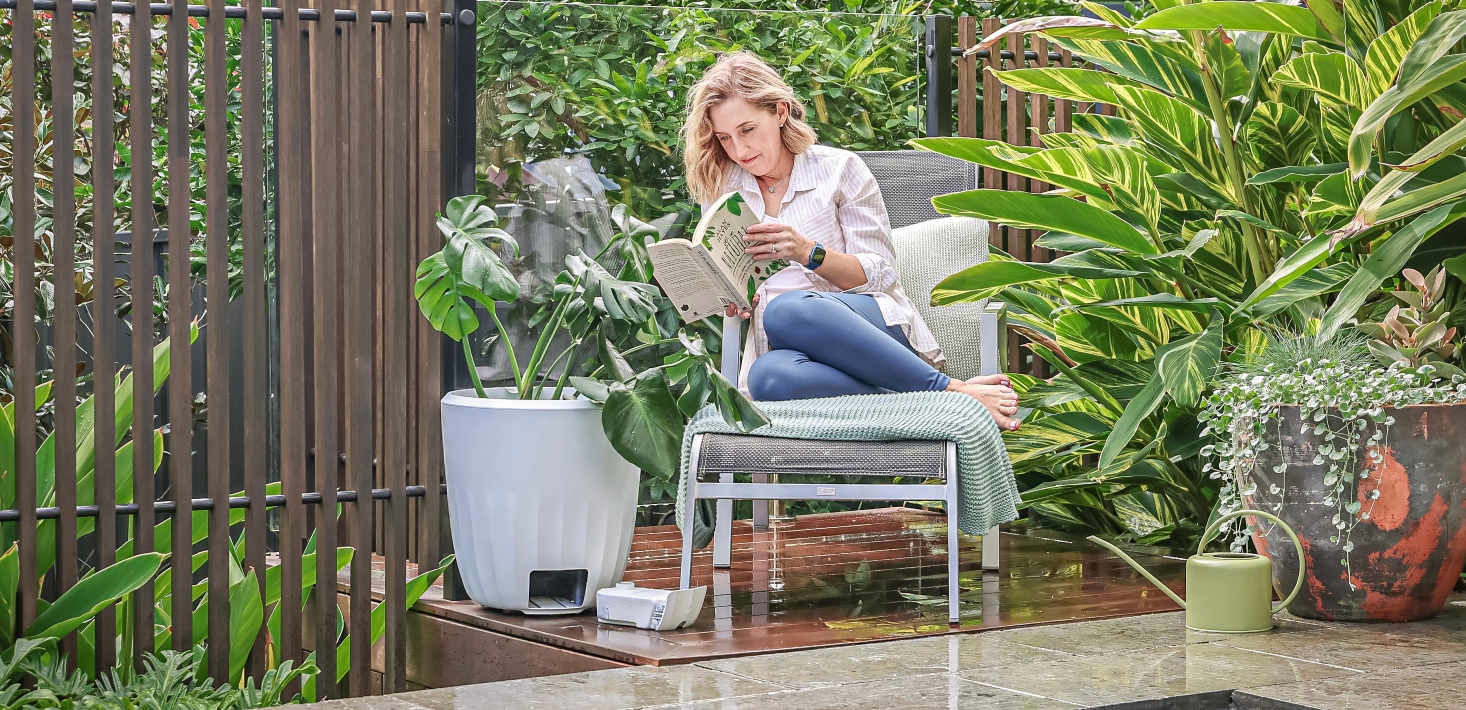
PerkyPod founder Louise Burr. Source: Megann Evans Photography
After being officially discharged from her 25-year-career as an Air Force Officer on medical grounds in late 2023, mum-of-three and founder of PerkyPod Louise Burr saw an opportunity to give the launch of the world’s first self-draining plant pot her full attention and solve the major problems facing plant owners in homes and businesses across Australia.
PerkyPod is a patent-pending plant pot that contains internal drainage, filtration and a water catchment system, offering an alternative to the current self-watering pots already on the market.
Burr held a soft launch for PerkyPod pre-orders in February 2024, before pausing its marketing for a few weeks to incorporate lessons from the pre-order phase.
Now, after three years of extensive research and development with interior designers, industrial designers, marketing coaches, landscapers and nurseries, the entrepreneur is ready to release the Sydney-made pots to the public on Sunday, April 7.
Self-draining vs self-watering plant pots
Speaking to SmartCompany, Burr says PerkyPod fills a gap in the market for people wanting plant watering solutions.
“Self-watering pot plants are meant to work by having their bottom reservoir filled with water, then the plant is meant to drink what it needs via a ‘wicking’ concept,” she explains.
“However, there are many limitations with this approach. Market research shows that most plant owners don’t trust the wicking concept as plants don’t often thrive.
“This results in owners watering over the top of the plant and avoiding using the reservoir, which defeats the purpose.
“But we keep buying them because at least they prevent the mess from drips and there has never really been an alternative option.”
According to Transparency Market Research (TMR), the self-watering pot industry was valued at US$302.6 million in 2021 and is estimated to reach US$649.6 million by the end of 2031.

Founder Louise Burr relaxing by the pool with PerkyPod. Source: Megann Evans Photography
The key factors driving the industry are awareness of the advantages of self-watering pots and an increase in indoor planting activities in residential and commercial sectors.
Burr says major issues with self-watering plant pots include owners providing the same amount of water to all plants, despite every plant having its own unique requirements.
“The reservoir opening is really little so it’s hard to fill up with water and impossible to see if there’s still any water in there,” she says.
“Larger sizes can become really heavy, which makes them difficult to move around and water usually stagnates in the reservoir and becomes foul, attractive to plant pests, and smelly if you’ve used fertiliser, and causes unsightly calcium build-up and water stains.”
Burr says PerkyPod solves all these issues as its unique internal drainage and water catchment system means owners can tailor the amount of water, fertiliser, and frequency to each plant’s needs.
“Excess water gets filtered and funnelled into a removable catchment drawer, which prevents puddles and no stagnant water. This minimises plant pests and enables routine fertiliser applications,” she says.
“Emptying the water drawer can be done whenever the owner has time, or left for the next watering session, so it’s perfect for anyone who is time-poor. They can just water their plant and not stress about messes or lifting.
“PerkyPod has optional castor wheels that are hidden underneath, so plants are really easy to move around or even spin on the spot. This helps with sweeping, decor changes and chasing perfect lighting conditions.”
A market of plant carers
In 2022, PerkyPod conducted a plant care survey of more than 100 Australians. It found 80% of plant owners are dissatisfied with self-watering plant pots, and 91% worry about over or underwatering their plants.
Approximately 88% said they have killed a plant and suspect it was due to incorrect watering, and 80% would have more plants if plant chores were easier, with 75% reporting that plants added to their ‘mental load’.
Expanding on the survey results, Burr says PerkyPod learnt most plant owners knew they had to water their plants thoroughly each time, which meant having water pouring out the bottom of the pot to ensure every root has had a drink.
“However, no one knew of a solution that would enable them to do this without having to risk dirty puddles or moving their plant elsewhere,” she says.
So far, Burr says the majority of PerkyPod’s orders have been from high-density areas of Sydney, Brisbane and Melbourne.
“Presumably as customers see the value of using PerkyPods on apartment balconies,” she says.
“Our customers are equally split between using PerkyPod for ornamental house plants versus grow-your-own herbs, fruit and vegetables.”
Currently, PerkyPod is focusing on Australia through direct-to-consumer sales, plus wholesale and trade.
Burr says the startup has some stockists in its hometown of Newcastle and is working with a wholesale business coach to expand into nurseries and homewares stores around Australia.
“Once we are established in Australia, we plan to expand in North America, Asia and Europe. We are interested in partnering with businesses that share our values and vision,” she says.
“We have entirely bootstrapped PerkyPod and we’ve invested significantly into tooling to create one size of PerkyPod, a large size with 40cm diameter and 42cm height.
“However, profits will be reinvested into creating other sizes and shapes as soon as possible.”
Handpicked for you

Femtek secures $1 million for its cycle tracking ring you only wear to bed



COMMENTS
SmartCompany is committed to hosting lively discussions. Help us keep the conversation useful, interesting and welcoming. We aim to publish comments quickly in the interest of promoting robust conversation, but we’re a small team and we deploy filters to protect against legal risk. Occasionally your comment may be held up while it is being reviewed, but we’re working as fast as we can to keep the conversation rolling.
The SmartCompany comment section is members-only content. Please subscribe to leave a comment.
The SmartCompany comment section is members-only content. Please login to leave a comment.